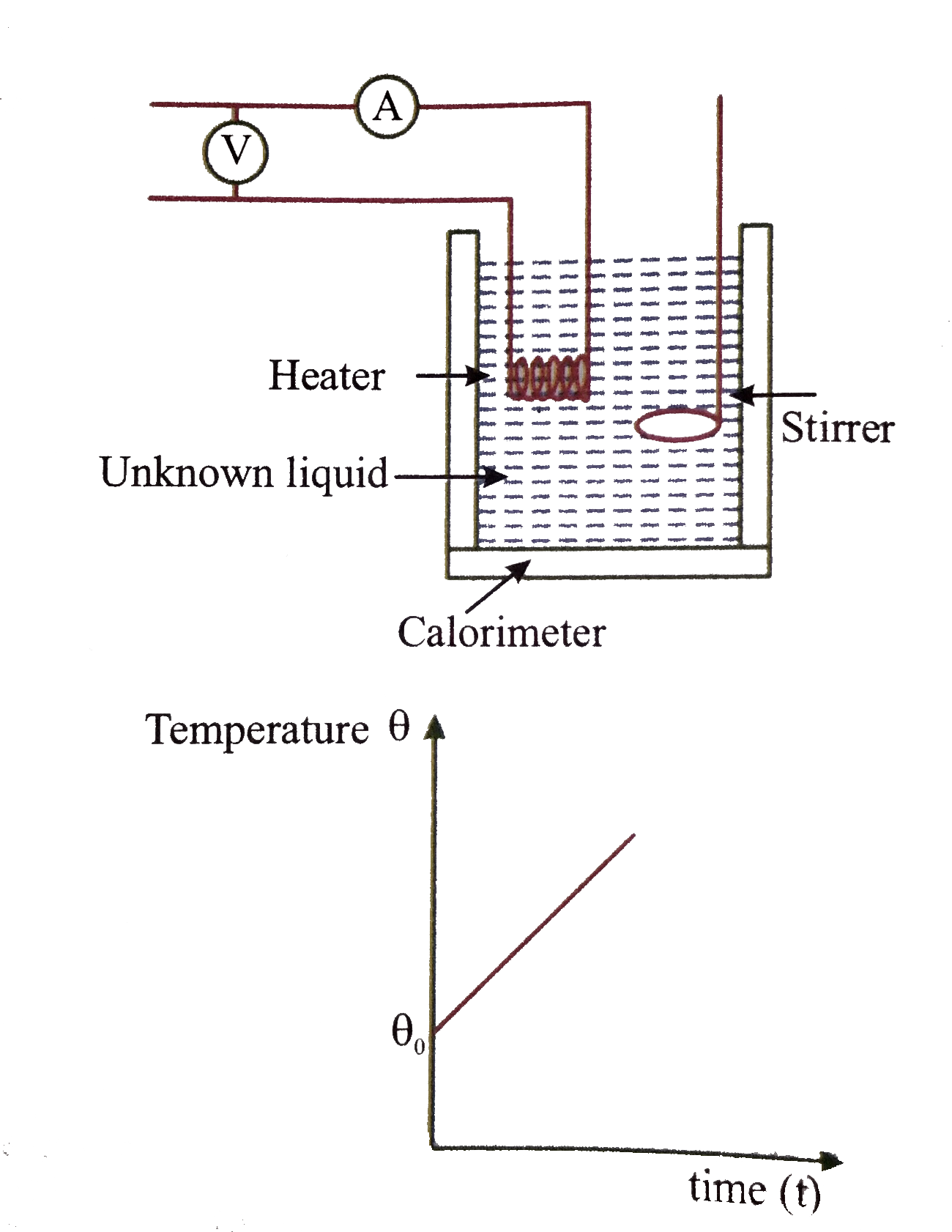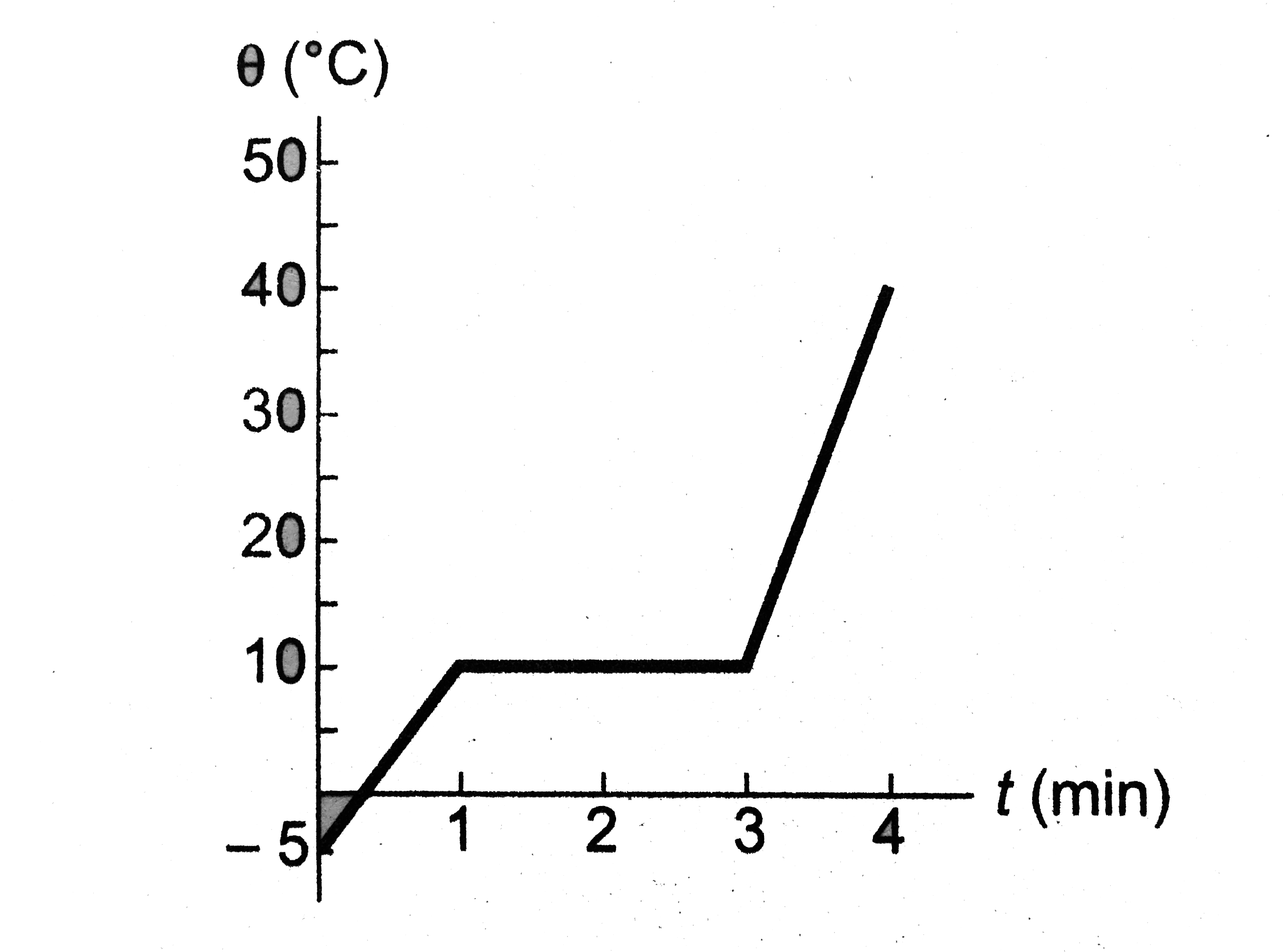The heat (Q) supplied to a solid, which is otherwise thermally isolated from it surrounding, is plotted as a function of its absolute temperature, θ. If is found that they are related by the equationQ=aθ2+bθ4 ( a, b are constants). The heat capacity of the solid is,
aθ33+bθ55
aθ+bθ3
aθ3+bθ55
2aθ+4bθ3
To find the heat capacity of the solid given the relation Q=aθ2+bθ4, we can follow these steps:
1. Understand the Relationship: We start with the equation given in the problem:
Q=aθ2+bθ4
Here, Q is the heat supplied, θ is the absolute temperature, and a and b are constants.
2. Define Heat Capacity: The heat capacity C of a substance is defined as the amount of heat required to change its temperature by one degree. Mathematically, it can be expressed as:
C=dQdθ
This means we need to differentiate Q with respect to θ.
3. Differentiate Q: We will differentiate the expression for Q:
dQdθ=ddθ(aθ2+bθ4)
Using the power rule of differentiation, we get:
dQdθ=2aθ+4bθ3
4. Final Expression for Heat Capacity: Thus, the heat capacity C of the solid is:
C=2aθ+4bθ3
Conclusion:
The heat capacity of the solid is given by:
C=2aθ+4bθ3
Q=aθ2+bθ4
Here, Q is the heat supplied, θ is the absolute temperature, and a and b are constants.
C=dQdθ
This means we need to differentiate Q with respect to θ.
dQdθ=ddθ(aθ2+bθ4)
Using the power rule of differentiation, we get:
dQdθ=2aθ+4bθ3
C=2aθ+4bθ3
The heat capacity of the solid is given by:
C=2aθ+4bθ3
Topper's Solved these Questions
- BOOK - PHYSICS GALAXY - ASHISH ARORACHAPTER - HEAT AND THERMAL EXPANSIONEXERCISE - NUMERICAL MCQs SINGLE OPTIONS CORRECT81videos
HEAT AND THERMAL EXPANSION
- BOOK - PHYSICS GALAXY - ASHISH ARORACHAPTER - HEAT AND THERMAL EXPANSIONEXERCISE - ADVANCE MCQs WITH ONE OR MORE OPTIONIS CORRECT24videos
HEAT AND THERMAL EXPANSION
- BOOK - PHYSICS GALAXY - ASHISH ARORACHAPTER - HEAT AND THERMAL EXPANSIONEXERCISE - DISCUSSION QUESTION24videos
HEAT AND THERMAL EXPANSION
- BOOK - PHYSICS GALAXY - ASHISH ARORACHAPTER - GEOMETRICAL OPTICSEXERCISE - Unsolved Numerical Problems107videos
GEOMETRICAL OPTICS
- BOOK - PHYSICS GALAXY - ASHISH ARORACHAPTER - HEAT TRANSFER EXERCISE - Unsolved Numerical Problems for Preparation of NSEP,INPhO&IPhO66videos
HEAT TRANSFER
Similar Questions
A copper calorimeter of negligible thermal capacity is filled with a liquid. The mass of the liquid is 250g. A heating element of negligible thermal capacity is immersed in the liquid. It is found that the temperature of the calorimeter and its contents rise form 25∘C to 30∘C in 5 minutes when a current of 2.05 amperes is passed through it at a potential difference of 5 volts. The liquid is throuwn off and the heater is switched on again. It is now found that the temperature of the calorimeter alone remains constant at 32∘C when the current through the heater is 0.7A at the potential differfnce 6 volts. Calculate the specific heat capacity of the liquid. The temperature of the surroundings is 25∘C.
View SolutionIn the above problem if heat is supplied at a constant rate of q=10cal/min, then plot temperature versus time graph.
View Solution
Knowledge Check
- Question 1 - Select One
Curved surface of a uniform rod is isolated from surrounding. Ends of the rod are maintained at temperatures T1 and T2(T1>T2) for a long time. At an instant, temperature T1 starts to decrease at a constant and slow rate. If thermal capacity of material of the rod is considered, then which of thefollowing statements is/are correct ?
A) At an instant,rate of heat flow near the hotter end is equal to that near the other endBRate of heat flow through the rod starts to decrease near the hotter end and remains constant near the other endCRate of heat flow is maximum at mid section of the rodDNone of these - Question 2 - Select One
A substance is in the solid from at 0∘C. The amount of heat added to this substance and its temperature is plotted in the graph . The specific heat capacity of the solid substance is 0.5cal/g∘C.
_E01_235_Q01.png)
Specific heat capacity in the liquid state is -A527cal/g∘CB527cal/gKC1027cal/g∘CDCan't say - Question 3 - Select One
Figure shows an electrical calorimeter to determine specific heat capacity of an unknown liquid, First of all, the mass of empty calorimeter (a copper container) is measured and suppose it is m1. Then the unknown liquid is poured in it. Now the combined mass of calorimeter+liquid system is measured and let it be m2. So the mass of liquid is (m2−m1). Initially both were at room temperature (θ0).
Now a heater is immeresed in if for time interval t. The voltage drop across the heater is V and current passing through it is I. Due to heat supplied, the temperature of both the liquid and calorimeter will rise simultaneously. After tsec, heater was switched off, and final temperature is θr. If there is no heat loss to surroundings. Heat supplied by the heater=Heat absorbed by the liquid+heat absorbed by the calorimeter (VI)t=(m2−m1)S1(θf−θ0)+m1Sc(θf−θ0)
The specific heat of the liquid S1=(VI)tθf−θ0−m1Sc(m2−m1)

Radiation correction: There can be heat loss to environment. To compensate this loss, a correction is introduced.
Let the heater was on for tsec, and then it is switched off. Now the temperature of the mixture falls due to heat loss to environment. The temperature of the mixture is measured t/2sec. after switching off. Let the fall in temperature during this time is ɛ
Now the corrected final temperature is taken as θf=θf+ɛ
If mass and specific heat capacity of calorimeter is negligible, what would be maximum permissible error in Sl. Use the date mentioned below.
m1→, Sl→0, m2=1.00kg,
V=10.0V, I=10.0A,
t=1.00×102sec, θ0=15∘C,
Corrected θ1=65∘CA4%B5%C8%D12%
As a physicist, you put heat into a 500 g solid sample at the rate of 10.0kJ/min, while recording its temperature as a function of time. You plot your data and obtain the graph shown in figure.
 .
.
(a) What is the latent heat of fusion for this solid?
(b) What is the specific heat of solid state of the material?View SolutionThe inernal energy of a solid also increases when heat is transferred to it from its surroundings. A 5 kg solid bar is heated at atmospheric pressure. Its temperature increases from 20∘C to 70∘C. The linear expansion coefficient of solid bar is 1×10−3/∘C. The density of solid bar is 50kg/m3. The specific heat capacity of solid bar is 200J/kgC∘. The atmospheric pressure is 1×10N/m2.
The heat transferred to the solid bar isView SolutionThe specific heat of many solids at low temperatures varies with absolute temperature T according to the relation S=AT3, where A is a constant. The heat energy required to raise the temperature of a mass m of such a solid from T = 0 to T = 20 K is
View SolutionThe specific heat of solids at low temperatures varies with absolute temperature T according to the relation S=AT3, where A is a constant. The heat energy required to raise the temperature of a mass m of such a solid from T=0 to T=20K is:
View SolutionThe inernal energy of a solid also increases when heat is transferred to it from its surroundings. A 5 kg solid bar is heated at atmospheric pressure. Its temperature increases from 20∘C to 70∘C. The linear expansion coefficient of solid bar is 1×10−3/∘C. The density of solid bar is 50kg/m3. The specific heat capacity of solid bar is 200J/kgC∘. The atmospheric pressure is 1×10N/m2.
The work done by the solid bar due to thermal expansion, under atmospheric pressure isView Solution

